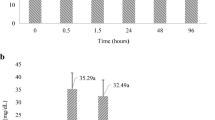Abstract
The effects of stress produced by noxious cutaneous stimulation on the concentration of 18 amino acids in the hemolymph of Aplysia californica were examined. The concentration of alanine and glutamate increased in response to stress and remained elevated for at least 6 h. The total amino acid concentration in the hemolymph did not change significantly in response to stress. It is concluded that stress evokes an increase in circulating alanine and glutamate levels. These factors may then act in a paracrine, endocrine, or neuroendocrine manner to modify stress-associated behaviors.
Similar content being viewed by others
Abbreviations
- AA:
-
amino acids(s)
- bw:
-
body weight
- SEM:
-
standard error of the mean
- SW:
-
sea water
References
Arch S, Smock T (1977) Egg-laying behavior in Aplysia californica. Behavioral Biology 19:45–54
Bablanian GM, Triestman SN (1985) The effect of hyperpolarization of cell R15 on the hemolymph composition of intact Aplysia. J Comp Physiol B 155:297–303
Baginski RM, Pierce SK (1978) A comparison of amino acid accumulation during high salinity adaptation with anaerobic metabolism in the ribbed mussel Modiolus demissus. J Exp Zool 203:419–428
Bulloch AGM (1989) Sprouting by intact Helisoma neurons: role for glutamate. J Neurosci Res 23:384–395
Cooper BF, Krontiris-Litowitz JK, Walters ET (1989) Humoral factors released during trauma of Aplysia body wall II. Effects of possible mediators. J Comp Physiol B 159:225–235
Eskin A (1982) Differential effects of amino acids on the period of the circadian rhythm from the Aplysia eye. J Neurobiol 13:231–239
Henry CD, Leslie J, Kulovich S (1991) Circulating free amino acids in Aplysia californica. Comp Biochem Physiol 100:629–632
Henry CD, Magnum CP, Webb KL (1980) Salt and water balance in the oligohaline clam, Rangia cuneata II. Accumulation of intracellular free amino acids during high salinity adaptation. J Exp Zool 211:11–24
Ichinose M, McAdoo DJ (1985a) Excitatory effect of amino acids on identified neuron R14 of Aplysia. I. Glycine-induced depolarization and its ionic mechanism. J Neurosci Res 14:129–143
Ichinose M, McAdoo DJ (1985b) Excitatory effect of amino acids on identified neuron R14 of Aplysia. II. Neutral amino acids and structure-activity relationships. J Neurosci Res 14:145–148
Iliffe TM, McAdoo J, Beyer CB, Haber B (1977) Amino acid concentrations in the Aplysia nervous system: neurons with high glycine concentrations. J Neurochem 28:1037–1042
Jones PG, Rosser SJ, Bulloch AGM (1987) Glutamate supression of feeding and the underlying output of effector neurons in Helisoma. Brain Res 437:56–68
Jones PG, Bulloch AGM (1988) Lxxx-Glutamate promotes neurite outgrowth in adult Helisoma neurons. Neurosci Res Comm 3:93–98
Kandel ER (1979) Behavioral biology of Aplysia. Freeman, San Francisco
Kehoe J (1975) Electrogenic effects of neutral amino acids on neutons of Aplysia californica. The synapse. Cold Spring Harbor Symp Quant Biol 40:145–155
Krontiris-Litowitz JK, Cooper BF, Walters ET (1989) Humoral factors released during trauma of Aplysia body wall I. Body wall contraction, cardiac modulation, and central reflex suppression. J Comp Physiol B 150:211–223
Lin C-Y, Krontiris-Litowitz JK, Cooper BF, Walters ET, McAdoo DJ (1987) Chemical characterization of factors released from Aplysia body wall by traumatic stimulation. Soc Neurosci Abstr 13:1072
Lin C-Y, Hughes MG, McAdoo DJ (1989) Amino acid uptake and incorporation into cell-specific peptided and evidence for intracellular peptide pools in Aplysia neurons R3–R14. Comp Biochem Physiol 92:143–150
Lukowiak K (1987) A blood-borne factor from food-satiated Aplysia, suppresses the gill withdrawal reflex in in vitro preparations from unsatiated animals. Neurosci Lett 77:205–208
Mackey S, Carew TJ (1983) Locomotion in Aplysia: triggering by serotonin and modulation by bag cell extract. J Neurosci 3(7): 1469–1477
Matsushima O, Khan H, Saleuddin SM (1991). Haemolymph protein as a source for free amino acid accumulation in the pulmonate Helisoma trivolvis during hypertonic stress. J Exp Zool 257:141–149
Palovcik RA, Basberg BA, Ram JL (1982) Behavioral state changes induced in Pleurobranchia and Aplysia by serotonin. Behav Neural Biol 35:383–394
Parsons DW, Pinsker HM (1989) Swimming in Aplysia brasiliana: behavioral and cellular effects of serotonin. J Neurophysiol 62:1163–1176
Pierce SK, Greenberg MJ (1972) The nature of cellular volume regulation in marine bivalves. J Exp Biol 57:681–692
Ram JL, Young ES (1992) Shock induces a long-lasting elevation of blood glucose in Aplysia. Experientia 48:14–18
Sawada M, Jara N, Ito I, Maeno T (1984) Ionic mechanism of a hyperpolarizing glutamate effect on two identified neurons in the buccal ganglion of Aplysia. J Neurosci Res 11:91–103
Sawada M, McAdoo DJ, Blankenship JE, Price CH (1981) Modulation of arterial muscle contraction in Aplysia by glycine and neuron R14. Brain Res 207:486–490
Yancey PH, Clark ME, Hand SC, Bowlus RD, Somero GN (1982) Living with water stress: evolution of osmolyte systems. Science 217:1214–1222
Author information
Authors and Affiliations
Rights and permissions
About this article
Cite this article
Krontiris-Litowitz, J.K., Walters, E.T. & McAdoo, D.J. Stress-elicited changes in amino acid levels of hemolymph of Aplysia californica . J Comp Physiol B 163, 671–675 (1994). https://doi.org/10.1007/BF00369518
Accepted:
Issue Date:
DOI: https://doi.org/10.1007/BF00369518



